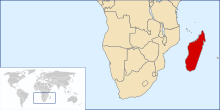| Madagascan sunset moth | |
|---|---|

| |
| Engraving captioned Urania riphaeus from Charles D. d'Orbigny's Dictionnaire universel d'histoire naturelle (1849) | |
| Scientific classification | |
| Domain: | Eukaryota |
| Kingdom: | Animalia |
| Phylum: | Arthropoda |
| Class: | Insecta |
| Order: | Lepidoptera |
| Family: | Uraniidae |
| Genus: | Chrysiridia |
| Species: | C. rhipheus
|
| Binomial name | |
| Chrysiridia rhipheus (Drury, 1773)
| |

| |
| Endemic to Madagascar | |
| Synonyms | |
| |
Chrysiridia rhipheus, the Madagascan sunset moth, is a species of day-flying moth of the family Uraniidae. It is considered one of the most impressive and appealing-looking lepidopterans.[10] Famous worldwide, it is featured in most coffee table books on Lepidoptera and is much sought after by collectors, though many older sources misspell the species name as "ripheus".[11][12] The colours originate from optical interference in the iridescent parts of the wings, while the black parts are pigmented.[7][13] Adults have a wingspan of 7–9 cm (2.8–3.5 in).
Dru Drury, who described the moth in 1773, placed it in the genus Papilio, considering it a butterfly. Jacob Hübner placed it in the moth genus Chrysiridia in 1823. Later redescriptions led to junior synonyms such as Chrysiridia madagascariensis (Lesson, 1831).[2]
At first the moth was thought to be from China or Bengal,[14][15] but was later found to be endemic to Madagascar. It is found throughout the year in most parts of the island, with peak populations between March and August, and smallest numbers between October and December. Females lay about 80 eggs under the leaves of Omphalea spp. The caterpillars are whitish yellow with black spots and red feet and are covered in club-ended black setae. Silk spun from the mouth helps the caterpillars hold on to smooth leaves and climb back to the plant when they fall. After completing four instars, the caterpillars spin an open network cocoon. The pupal stage lasts from 17 to 23 days.[16] Chrysiridia rhipheus is the sole specialist herbivore of the four species of Omphalea in Madagascar. Omphalea is toxic: the toxins are sequestered by the feeding caterpillar and retained in the pupal and adult stages.[17] Thousands of these moths migrate between the eastern and western ranges of their host plants.[16][17]
- ^ Belouino, Paul (1852). Dictionnaire général et complet des persécutions souffertes par l'Église (in French). Paris: J.P. Migne Éditeur. pp. 1784–1786. Retrieved 2008-02-16.
- ^ a b c d Cite error: The named reference
Kirbywas invoked but never defined (see the help page). - ^ Grote, A. R. (17 January 2008) [1874]. "Synonymical Note". The Canadian Entomologist. No.9. VI. Entomological Society of Canada: 180. Retrieved 2008-07-05.
- ^ Beccaloni, G.; Scoble, M.; Kitching, I.; Simonsen, T.; Robinson, G.; Pitkin, B.; Hine, A.; Lyal, C., eds. (2003). "Chrysiridia rhipheus". The Global Lepidoptera Names Index. Natural History Museum. Retrieved 2018-04-20.
- ^ Cite error: The named reference
Swainsonwas invoked but never defined (see the help page). - ^ Savela, Markku (15 March 2007). "Chrysiridia". Lepidoptera and Some Other Life Forms. Retrieved 2008-06-16.
- ^ a b Yoshioka, Shinya; Kinoshita, Shuichi (5 March 2007). "Polarization-sensitive color mixing in the wing of the Madagascan sunset moth". Optics Express. 15 (5). Washington: Optical Society of America: 2691–701. Bibcode:2007OExpr..15.2691Y. doi:10.1364/OE.15.002691. PMID 19532506.
- ^ a b Decary, Raymond (1950). La Faune Malgache (in French). Paris: Payot.
- ^ Biosecurity New Zealand (24 August 2005). "Import Health Standard for the Importation of Tropical Butterfly and Moth Pupae into New Zealand". Commercial Imports. New Zealand Government. Archived from the original on 2011-07-26. Retrieved 2006-11-08.
- ^ Cite error: The named reference
Taitwas invoked but never defined (see the help page). - ^ Cite error: The named reference
Smithwas invoked but never defined (see the help page). - ^ Cite error: The named reference
Griveaudwas invoked but never defined (see the help page). - ^ Cite error: The named reference
Prumwas invoked but never defined (see the help page). - ^ Cite error: The named reference
Drurywas invoked but never defined (see the help page). - ^ Cite error: The named reference
Boisduvalwas invoked but never defined (see the help page). - ^ a b Cite error: The named reference
Catalawas invoked but never defined (see the help page). - ^ a b Cite error: The named reference
LeesDavidSmithwas invoked but never defined (see the help page).